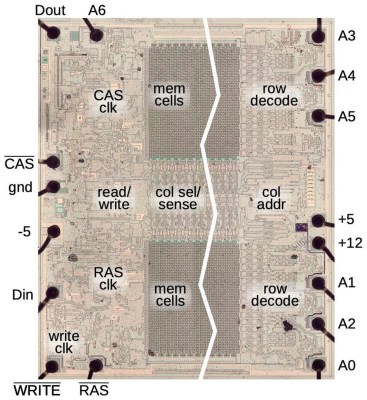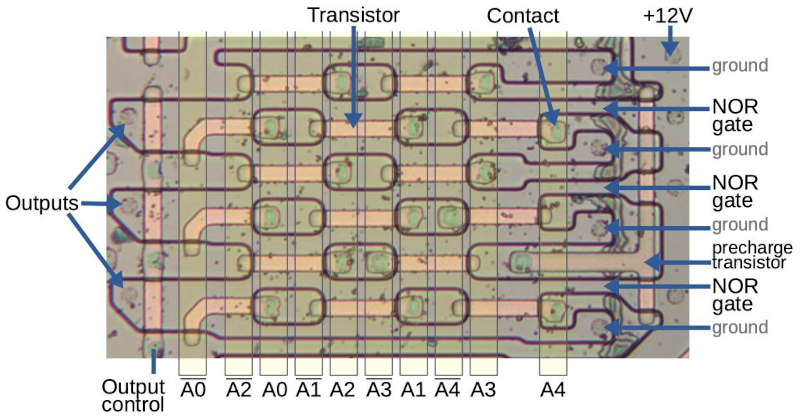[Ken Shirriff] is looking inside chips again. This time, the subject is the MK4116 — a 16 Kbit DRAM chip. Even without a calculator, you know that’s a whopping 2 Kbytes, and while that doesn’t sound impressive, in the late 1970s, it was a modern miracle.
The chip showed up in computers ranging from the TRS-80 to the Xerox Alto and was even a mainstay of arcade video games. While [Ken] thought it would be a pretty predictable teardown, he found several surprises.
 Static RAM chips use flip flops and retain their state as long as power is on. That’s convenient, but each flip flop takes multiple transistors, so there is a limit to how many bits you can put on a particular size chip. Dynamic RAM increases that limit because it is nothing more than a capacitor and a single transistor. This increases memory density, but the problem is that the capacitor doesn’t hold charge indefinitely. The computer or an associated circuit had to refresh the memory periodically to maintain the contents.
Static RAM chips use flip flops and retain their state as long as power is on. That’s convenient, but each flip flop takes multiple transistors, so there is a limit to how many bits you can put on a particular size chip. Dynamic RAM increases that limit because it is nothing more than a capacitor and a single transistor. This increases memory density, but the problem is that the capacitor doesn’t hold charge indefinitely. The computer or an associated circuit had to refresh the memory periodically to maintain the contents.
One of the key innovations for this chip was the use of multiplexed address lines so it could use a smaller package. Inside, two banks of capacitors store the bits, and, usually, a computer would use eight chips to store a byte. Of course, each memory bit is made to be as compact as possible. This chip is also made to be very low power when idle. The secret is that it doesn’t use load transistors but instead uses an active pull-up tied to the system clock. Another interesting feature is the sense amplifier, which has to measure the tiny noisy voltage from the capacitors.
You’ll see all this and more in [Ken’s] write-up. Chips from that era were relatively easy to take apart compared to today’s devices. Want to know how it’s done? [Ken] can tell you. He is well-known for doing a lot of cool stuff, with ICs and even old mainframe and space hardware.
















Note the writeup is from 2020; hes done quite a lot more since then
Lol, I was already wondering why I didn’t see this one on Twitter recently :D. Must’ve missed it in 2020.
I thought my RSS feed was broken. I came across Ken’s blog (via CuriousMarc) only late last year, and didn’t go back to the beginning.
My eyes usually glaze over about halfway through his posts, but it’s fascinating nonetheless.
That doesn’t detract from the quality of the article or research though; I always look forward to [Ken Shirriff]’s work featuring here. And all the better for being a written article that can be studied as necessary rather than flying past in a YT video in a blaze of ads.
In the day, there was a hackaday equivalent project in an electronics magazine that had you desolder the lid of one of these, put a lens on top, and write the memory to all 1s (or zeros, can’t remember), then wait a bit, then read it out. You got the equivalent of a CCD camera !!!